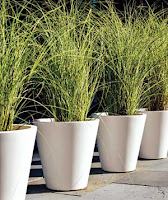A trend so new it is just now emerging, the new design
vibe for large containers is to plant each with a single type of ornamental, then arrange the containers in a group. For
many years (since before 2000) containers used for garden accents have been
stuffed with loads of different kinds of plants. For example a Crabapple blog from
last year explored the “Thrillers, Fillers, Spillers technique” of combining
many types of plants into one container. But there are several advantages to mono-plantings.
Clusters of pots offer immediate impact
The reason to group containers is because the total effect is greater than the sum of the individual pots. By concentrating on a single flower type or color, the impact is magnified. Beautiful color and texture effects are easy when grouping individual plants selected for bold and dramatic design.
The reason to group containers is because the total effect is greater than the sum of the individual pots. By concentrating on a single flower type or color, the impact is magnified. Beautiful color and texture effects are easy when grouping individual plants selected for bold and dramatic design.
Container
groupings provide unrivaled flexibility
The design element of repetition is added to the landscape by planting a number of matching containers with a single type of plant. A variety of complementary containers also make an attractive grouping for patio, poolside or deck. By varying heights, tall background plants and cascading plants for the foreground add multilevel detail.
Horticultural
Advantages
Another
advantage is that plants requiring different moisture levels can be watered
according to their needs, instead of taking “pot luck” in a mixed container. Broad, waxy succulents that need little watering can co-exist with delicate flowers or ferns that require more water, and both can thrive.
Whether
an ensemble of colorful annuals and bold tropicals for summer, a utilitarian planting of herbs, or a high-impact
planting of winter hardy shrubs, perennials and bulbs, your Crabapple Rep can
design and select the best containers to match your architecture and reflect the
style
of the properties you manage. Make an appointment to discuss an exciting grouping
of pots to emphasize and enhance your community.
Photo Credits: GardeningGarden.com, DesigningOnline.com, RealSimple.com, and iherb.org





No comments:
Post a Comment